Strawberries
A New Way to Manage Weeds in the Anchor Rows of Tunnels
A cover crop can be a useful way to prevent weeds in anchor rows.
Cover crops in anchor rows can suppress weed growth and additionally help to minimize soil erosion and nutrient and sediment loss when it rains. Densely planted cover crops can outcompete weed seedlings germinating from the soil and prevent wind-dispersed seeds from reaching the wet soil surface. Have a look at the newly revised weed section in the Caneberries Pest Management Guidelines on the UC IPM web site.
As readers know, tunnels used for caneberry cultivation have the advantage that even when it rains caneberries remain dry which helps with fruit quality and yield. However, during rains, the water drains from the plastic cover of the tunnel and down into rows that contain the anchoring posts of the tunnel structure. The accelerated runoff in these post rows can cause soil erosion, sediment and nutrient loss. As such, the persistent soil moisture in post rows also promotes weed growth. These weeds, while maybe not competing directly with canes, can reproduce and quickly spread into neighboring cane rows.
Cover crops in the anchor rows are especially helpful when managing weeds that are difficult to control with fumigation because of their hard impermeable seed coats (mallows and filaree), or that have developed resistance to herbicides such as glyphosate and paraquat (hairy fleabane and horseweed).
Cover crops can be managed with mowing or herbicides to avoid seed production.
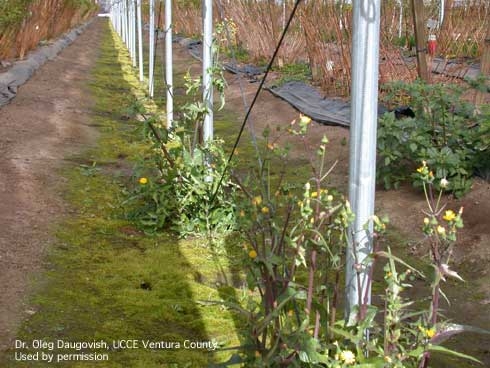
Weeds growing in anchor row in caneberry tunnel production. Photo courtesy Oleg Daugovish, UCCE.
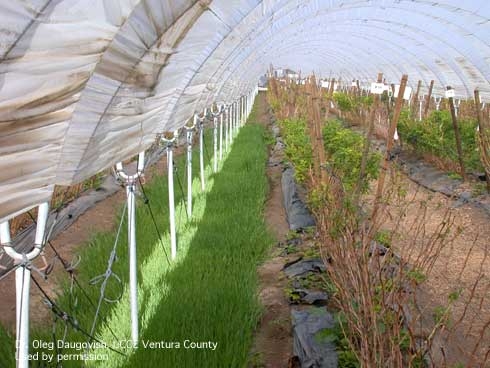
Cover crop growing in the anchor row in caneberry tunnel production. Photo Oleg Daugovish, UCCE.
Data Driven Decision Making: Finding Success in Plant Diagnostics and Stock Speculation
Stock speculation and plant diagnostics are surprisingly similar in the process and attitudes necessary for successful outcomes. In both endeavors, one must address an issue by gathering data about it, assess it correctly and make a decision in a timely matter.
The beauty of the stock market, and the lesson it provides those of us working in other areas of data driven decision making, is how swiftly information that really matters is integrated into the prices of shares. The successful stock operator needs to be constantly mindful of the data capable of influencing the present and future prices of the shares he or she is considering purchasing or selling. Not everything crossing the ticker tape or news crawl on the bottom of the screen is of equal value. Market commentary of the popular punditry and prognosticators is near useless (and potentially dangerous) in making decisions, while unexpected electoral outcomes and even small changes in national bank policy of large economies will have significant effects on markets. The key point is that information of real value is almost instantly reflected in the price of shares, putting the ability to identify the facts and make sound decisions on them quickly at a real premium and quite often will result in profitable speculation.
In the same vein, the effective plant diagnostician should ignore guesses and empty theories all the while taking into full consideration all the possible information about a problem available at that time. Experience tells us that in berries, it is valuable to pay attention to the duration of transplant cold conditioning, planting date, source nursery, type of fumigation or preplant treatment, plant tissue mineral concentrations, soil physical and chemical composition, plant establishment practices, former and current presence/absence of major pests, irrigation practices and fertilizer management.
While in plant diagnostics the practitioner is spared the split second requirement to make a decision as on the stock market, there is still a premium on making sound decisions and acting on them in a timely manner. The effects of unaddressed maladies are incorporated into current and future plant performance rapidly, and so the time to address a problem is nevertheless very soon after the complaint is noticed or received.
In the assessment of the data in reference to making a decision, one of the biggest mistakes a stock speculator and plant diagnostician can make is to create narratives, in other words stories, to explain what is occurring. Narratives have been a wonderful mechanism for humans to understand and survive in a constantly changing and bewildering world, but they can also lead to the creation of dangerous and misleading fictions, which elevate some information over other data vital to a true picture of what is really happening.
Take for example the rush to buy gold on the part of many investors over the past few years. Historic levels of Federal Reserve monetary activity through the release of billions and billions of dollars into circulation concurrent with significant government intervention in the economy compelled some investors to create a narrative of impending hyperinflation, and had them seeking refuge in the supposed store of eternal value in gold. This narrative of roaring inflation in the near future blinded many to the fact that through this entire time, the prices of Treasury bonds, which are a measure of the market's faith in the US government along with being extremely sensitive to and wary of inflation, were hitting all time highs in price arising from unprecedented demand. This cherry picking of facts and the creation of a story by some market participants resulted in a pretty decent bubble in gold for several years but now whose fiction has been cruelly exposed by the sharp drop in gold prices over the past two months (Figure 1 below).
Similarly, approaching a berry field and creating a narrative by focusing on and elevating one factor and ignoring the many other possibilities can result in a mistaken or incomplete diagnosis. Just because you find a pest or identify one problem doesn't necessarily mean that's all of it.
Take for example the issue of yellow leaves in strawberries (Figure 2 below) and caneberries. It has been a habit to simply refer yellowed leaves to some nutritional deficiency such as nitrogen, iron or zinc. A simple check in the literature or the web shows that indeed leaves can become yellow when one of these vital minerals is lacking, but which one? Furthermore, let me assure you as a person who makes a lot of diagnostic field visits that there are many, many causes of yellowing of strawberry and caneberry leaves! Each case really needs to be fully investigated on its own merits, lest the cure applied is not the right one, allowing valuable time to slip by and the plant declines further in yield potential or ends up wilting and dying. Much as the narrative-creating gold bugs in the above example lost vast sums of money in the recent sell off, growers acting on the narrative that iron is the cause of a given case of yellowed leaves because that's the way it looks in the book and then going on to ignore all of the other things in that field are going to get hit with a big loss if it turns out to be something else.
I would like to close this article with a note about proper attitude. As human as it is to err, it is even more human to not want to admit to making mistakes. Both plant diagnosticians and stock speculators must be able to neutrally approach their craft, because stubbornness and an inability to admit being wrong means you have mentally blocked out the possibility of making any decision other than the one to which you have attached yourself. It's very hard for many of us to fess up to a mistake because it's embarrassing or we are emotionally attached to our theory or whatever, but the net result of this inability to make the necessary change in attitude to agree with what is truly happening will be a failure to achieve the right solution to the real problem.
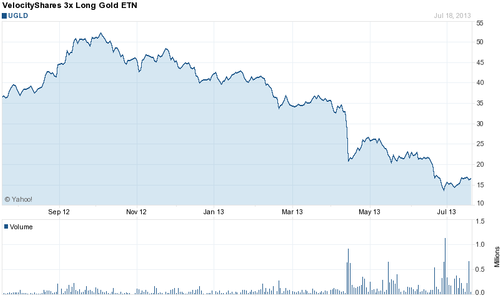
Figure 1: Dude, what happened to my gold fund?
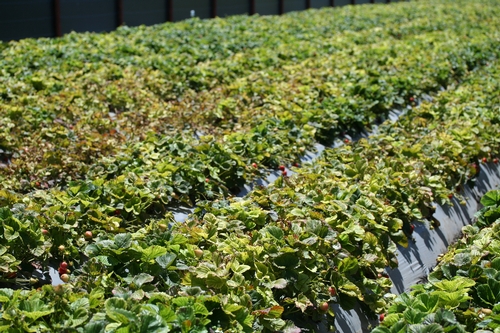
Figure 2: Are these plants really short of iron?
Viruses of Strawberry in 2013
A number of instances of underperformance and strawberry plant collapse in Santa Maria and Salinas along with the identification of the viruses responsible have brought around attention to this aspect of plant pathology in strawberry:
//ucanr.edu/blogs/blogcore/postdetail.cfm?postnum=10773
To add to this fine article, three weeks ago I had the good fortune to attend with my colleague Steve Koike a seminar given by University of Arkansas virologist Dr. Ioannis Tzanetakis. The theme was viruses in blackberries, but we learned a few important principles associated with viruses in berries in general.
Three topics of interest:
Titer of virus in contrast to its identification: A key point brought up was that the type of each virus is less important to the plant response than its very presence and titer (concentration). In other words, the response of the plant is correlated stronger to the total amount of virus present rather than to their taxonomy. Importantly, virus infections which are expressed like this additively would be seen in the field as plants having heavy exposure expressing more severe decline than those which have less. Therefore, symptoms would be manifested over a range, rather than simply just dead plants or live plants.
Viral transmissibility by vectors varies. We discussed the 2003 virus decline in Watsonville and Salinas strawberries resulting from an association of strawberry pallidosis and beet pseudo yellows virus along with twelve other viruses.
USDA- ARS virologist Dr. Bill Wintermantel, who pointed out that at a success rate around 80%, strawberry pallidosis is very transmissible by whiteflies, but since the background levels are usually low it doesn’t get moved around very much even though it transmits so easily. However, when an area like the fields along the coast in Watsonville in 2003 and then again in certain areas of Guadalupe last fall are swamped with the huge inflows of whiteflies as they did, even a low percentage of pathogen in the background doesn't matter because the low probability of transmission is overwhelmed by the number of attempts and the odds of success rise greatly.
Beet pseudoyellows virus, which was part of the problem in 2003, but not in 2013 apparently, has a far lower rate of transmissibility by whiteflies. However, since the background levels are so high in many local weed and crop plant species, it again has fair odds of getting moved around when the numbers of whiteflies are high.
Virus infection of strawberries the Eastern United States: Dr. Tzanetakis expanded on the topic of viruses in strawberry by talking about the virus infection this past season in Florida and several other states of the Eastern USA. The infection was traced back to a single nursery in Nova Scotia which was situated next an untreated commercial field and virtually 100% of the plants were later found to be infected with strawberry mild yellow edge virus (SMYEV) and strawberry mottle virus (SMoV), both of which are aphid transmitted.
More from Growing Produce online:
http://www.growingproduce.com/article/34043/strawberry-virus-alert
Testing a Field of Yellow Strawberry Plants in Salinas for Sodium Toxicity
The following is a test of the thesis proposed last year concerning the emergence of yellowed strawberry plants in many fields around Salinas and Castroville. To review, in the field tested last year, areas of yellow plants were found to be associated with high levels of calcium carbonate (lime), meaning that calcium tied up with carbonates was not available to limit the amount of exchangeable sodium, subsequently leaving this sodium to poison the strawberry plants and turn them yellow.
The test was done in a field in the Salinas area demonstrating classic symptoms. This particular field has several very large areas of yellowed plants, interspersed with areas of green plants which are apparently doing quite well.
I took four bulk tissue samples from each area of green plants and then another four bulk tissue samples from each area of yellow plants. Since we found last year that the very top of the bed is the area which shows the most dramatic differences in sodium concentration, a total of three bulk soil samples were taken from these levels in corresponding areas of green and yellow plants.
Refer to the tables below for the results of the tissue and soil tests.
Table One. Tissue Mineral Concentrations
|
Mineral |
Yellow Plants |
Green Plants |
|
Total Nitrogen (%) |
2.40 |
2.09* |
|
Total Phosphorous (%) |
0.74 |
0.65 |
|
Total Potassium (%) |
0.98 |
0.75 |
|
Total Sulfur (ppm) |
0.18 |
0.14 |
|
Total Boron (ppm) |
96.09 |
74.36 |
|
Total Calcium (%) |
1.00 |
1.31 |
|
Total Magnesium (%) |
0.39 |
0.42 |
|
Total Zinc (ppm) |
22.20 |
19.08 |
|
Total Manganese (ppm) |
141.82 |
169.60 |
|
Total Iron (ppm) |
230.31 |
256.02 |
|
Total Copper (ppm) |
7.78 |
6.54 |
|
Total Molybdenum (ppm) |
1.31 |
0.99 |
|
Total Sodium |
595.40 |
148.43* |
|
Total Chloride |
2683.92* |
3737.57 |
* Probability that the two sets are the same is less than or equal to 5% (p <0.05) using a Student's paired t-Test of two-tailed distribution.
Table Two. Soil Mineral and Chemical Characteristics
|
Mineral |
Yellow Plants |
Green Plants |
|
Nitrate (NO3-N) - ppm |
17.3 |
8.9 |
|
Ammonia (NH3-N) - ppm |
3.4* |
6.0 |
|
Phosphorous - ppm |
41.9 |
44.6 |
|
Potassium – ppm |
216.9 |
234.1 |
|
Calcium – ppm |
4989.6 |
3935.0 |
|
Magnesium – ppm |
1503.0 |
1138.5 |
|
Sodium – ppm |
386.2 |
335.6 |
|
Chloride – ppm |
15.2 |
17.3 |
|
SAR |
2.8 |
2.6 |
|
Zinc -ppm |
1.4 |
1.6 |
|
Iron - ppm |
9.6 |
10.5 |
|
Manganese - ppm |
3.4 |
2.4 |
|
Boron |
1.1 |
1.1 |
|
Soil pH |
7.8 |
7.6* |
|
Percent carbonates as CaCO3 |
1.41 |
0.92* |
* Probability that the two sets are the same is less than or equal to 5% (p <0.05) using a Student's paired t-Test of two-tailed distribution.
It is very easy to ascertain that this field situation is very similar to the field in Castroville evaluated last year. Sodium in the tissues of the yellowed plants is extremely high with an average of 595 ppm, compared against an average of 148 ppm in the green. Chloride curiously is lower in the yellow than in the green, but both averages are not exceedingly high.
Looking at the soil, we again find that the percent carbonates as calcium carbonate are significantly lower around the green plants than the yellow and the pH is also consequently lower around these green plants.
This indicates that calcium is being tied up around the yellow plants and not limiting the amount of exchangeable sodium. These high levels of sodium are being in turn absorbed by the plants causing them to turn yellow and in some cases even die.
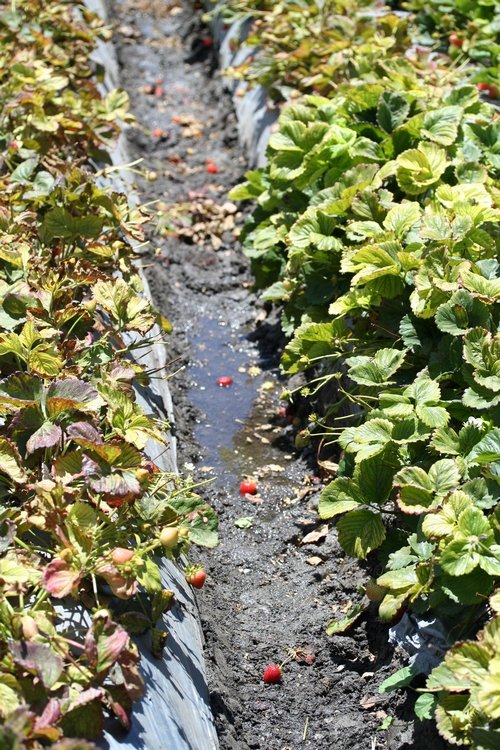
A bed of yellow strawberries next to one more or less green.
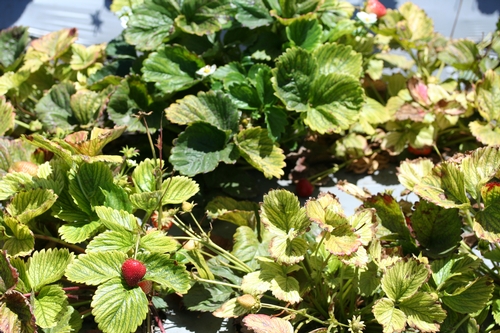
Green strawberry plant surrounded by yellow plants.
Thimbleberries on the Central Coast
Raspberries, blackberries, blueberries and strawberries aren't the whole story of berries on the Central Coast. There are many other species to be found around the farms and forests of our area.
The photos below are of thimbleberries, a species of Rubus found in the forests of the Santa Cruz mountains. This set of photos was taken in the lower reaches of Nisene Marks State Park.
Thimbleberries, Rubus parviflorus, are commonly found growing in the woods next to clearings in humus rich soil. The plants can be quite tall and over one's head in height. The foliage has a maple-leaf shape, is velvety and is rather large at some six to ten inches across on a fully grown plant. The canes are not thorny, and fruit is borne sparsely in clusters of three to five on second year canes.
The fruit of the thimbleberry are each composed of multiple druplets, and are quite soft when ripe so I doubt they would ship very well. They aren't super tasty. At any rate, the season is underway right now, and will probably continue for another two weeks or so in Santa Cruz County.
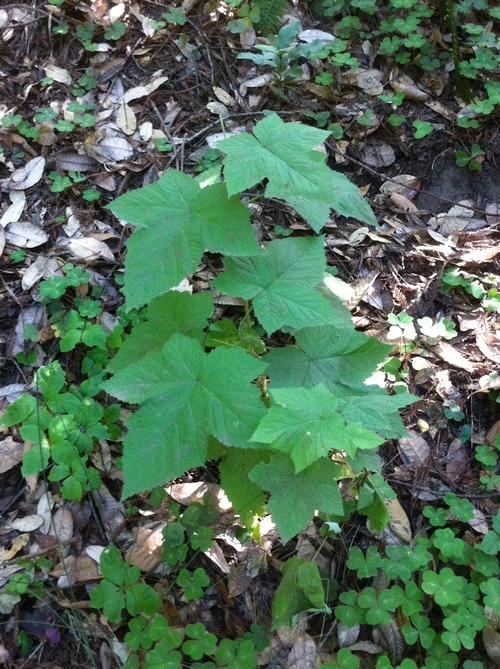
Smaller first year cane of thimbleberry.
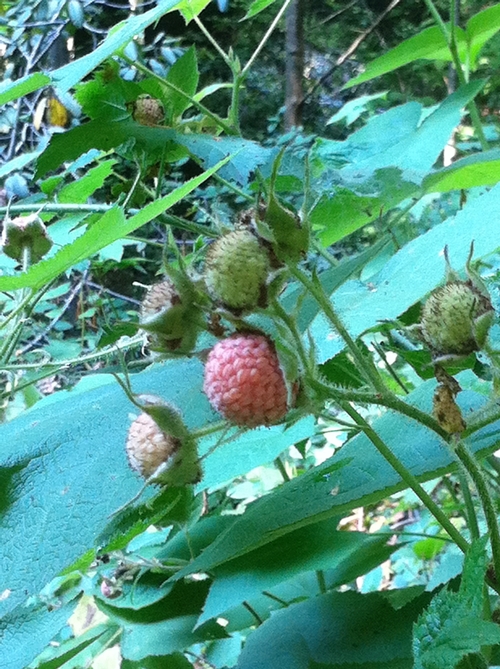
Thimbleberries ripening in a cluster on a trailside plant.
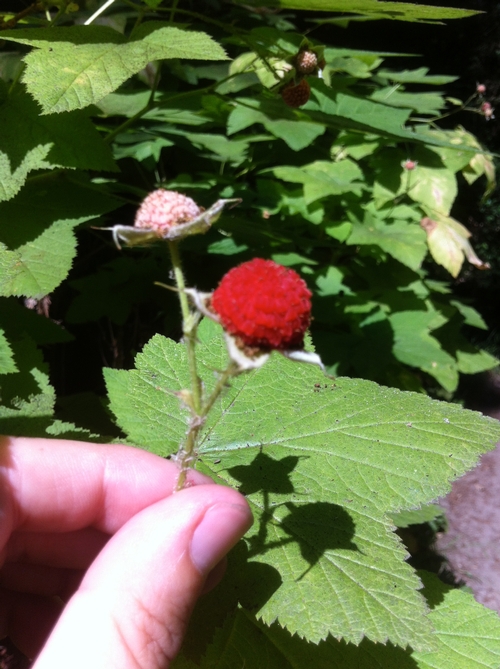
Fully ripe thimbleberry.

